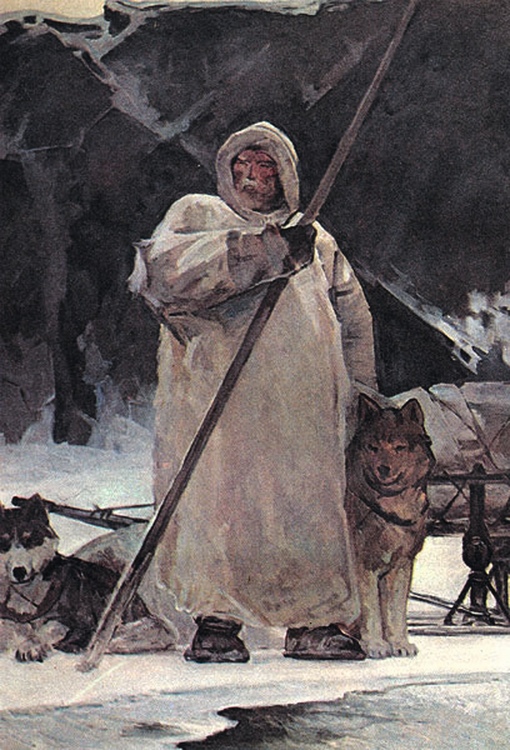Semion Chelyuskin on:
[Wikipedia]
[Google]
[Amazon]
 Semyon Ivanovich Chelyuskin (; c. 1707 – 1764) was a Russian polar
Semyon Ivanovich Chelyuskin (; c. 1707 – 1764) was a Russian polar
explorer
Exploration is the process of exploring, an activity which has some Expectation (epistemic), expectation of Discovery (observation), discovery. Organised exploration is largely a human activity, but exploratory activity is common to most organis ...
and naval officer
An officer is a person who holds a position of authority as a member of an armed force or uniformed service.
Broadly speaking, "officer" means a commissioned officer, a non-commissioned officer (NCO), or a warrant officer. However, absent ...
.
Chelyuskin graduated from the Navigation School in Moscow. He first became a deputy navigator
A navigator is the person on board a ship or aircraft responsible for its navigation.Grierson, MikeAviation History—Demise of the Flight Navigator FrancoFlyers.org website, October 14, 2008. Retrieved August 31, 2014. The navigator's prim ...
while serving in the Baltic Fleet
The Baltic Fleet () is the Naval fleet, fleet of the Russian Navy in the Baltic Sea.
Established 18 May 1703, under Tsar Peter the Great as part of the Imperial Russian Navy, the Baltic Fleet is the oldest Russian fleet. In 1918, the fleet w ...
(1728) and later promoted to navigator (1733). Chelyuskin was chosen for the Second (Great Northern) Kamchatka Expedition, in which he took part until 1743. He participated in expeditions, led by Vasily Pronchischev and Khariton Laptev. In spring of 1741, Chelyuskin made a voyage from the Khatanga River to the Pyasina River by land. He described the western coastline from the Taimyr Peninsula to the Middendorff Bay and then from the mouth of Pyasina to the mouth of the Yenisei River
The Yenisey or Yenisei ( ; , ) is the list of rivers by length, fifth-longest river system in the world, and the largest to drain into the Arctic Ocean.
Rising in Mungaragiyn-gol in Mongolia, it follows a northerly course through Lake Baikal a ...
. In winter of 1741–1742, he traveled from Turukhansk to the mouth of the Khatanga River, describing the northern coastline of the Taimyr Peninsula from the Faddey Bay on the East to the mouth of the Taimyra River on the West. Chelyuskin found the northern extremity of Asia
Asia ( , ) is the largest continent in the world by both land area and population. It covers an area of more than 44 million square kilometres, about 30% of Earth's total land area and 8% of Earth's total surface area. The continent, which ...
, which Aleksandr Fyodorovich Middendorf
Alexander Theodor von Middendorff (; 18 August 1815 – 24 January 1894) was a Russian zoologist and explorer of Baltic German and Estonians, Estonian extraction. He was known for his expedition in 1843–45 to the extreme north and east of Sib ...
would later name after him in 1843 ( Cape Chelyuskin).
He was discharged from the Baltic Fleet in the rank of a captain
Captain is a title, an appellative for the commanding officer of a military unit; the supreme leader or highest rank officer of a navy ship, merchant ship, aeroplane, spacecraft, or other vessel; or the commander of a port, fire or police depa ...
in 1760.
Named in honor
Cape Chelyuskin (the northernmost cape ofEurasia
Eurasia ( , ) is a continental area on Earth, comprising all of Europe and Asia. According to some geographers, Physical geography, physiographically, Eurasia is a single supercontinent. The concept of Europe and Asia as distinct continents d ...
), Chelyuskin Peninsula (northern tip of Taymyr), Chelyuskin Island near Taymyr, famous Soviet Chelyuskin steamship and some streets and settlements have been named after Chelyuskin.
In 1930s the Soviet Union
The Union of Soviet Socialist Republics. (USSR), commonly known as the Soviet Union, was a List of former transcontinental countries#Since 1700, transcontinental country that spanned much of Eurasia from 1922 until Dissolution of the Soviet ...
operated a steamship
A steamship, often referred to as a steamer, is a type of steam-powered vessel, typically ocean-faring and seaworthy, that is propelled by one or more steam engines that typically move (turn) propellers or paddlewheels. The first steamships ...
built in Denmark
Denmark is a Nordic countries, Nordic country in Northern Europe. It is the metropole and most populous constituent of the Kingdom of Denmark,, . also known as the Danish Realm, a constitutionally unitary state that includes the Autonomous a ...
in 1933, SS ''Chelyuskin'', named after Semion Chelyuskin. It sank in the Chukchi Sea
The Chukchi Sea (, ), sometimes referred to as the Chuuk Sea, Chukotsk Sea or the Sea of Chukotsk, is a marginal sea of the Arctic Ocean. It is bounded on the west by the Long Strait, off Wrangel Island, and in the east by Point Barrow, Alaska, ...
near Kolyuchin Island during an ill-fated attempt to cover the Northern Sea Route
The Northern Sea Route (NSR) (, shortened to Севморпуть, ''Sevmorput'') is a shipping route about long. The Northern Sea Route (NSR) is the shortest shipping route between the western part of Eurasia and the Asia-Pacific region.
Ad ...
.
The 1965-built icebreaker
An icebreaker is a special-purpose ship or boat designed to move and navigate through ice-covered waters, and provide safe waterways for other boats and ships. Although the term usually refers to ice-breaking ships, it may also refer to smaller ...
''Ledokol-8'' was renamed ''Semyon Chelyuskin'' in 1966.
References
{{DEFAULTSORT:Chelyuskin, Semion 1700s births 1764 deaths People from Peremyshlsky District Explorers of the Arctic Russian polar explorers 18th-century military personnel from the Russian Empire 18th-century explorers from the Russian Empire Imperial Russian Navy personnel Great Northern Expedition